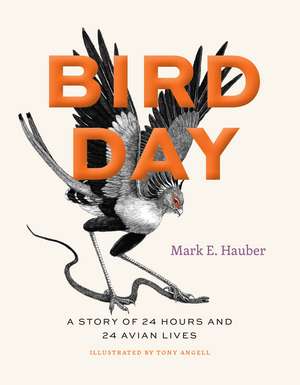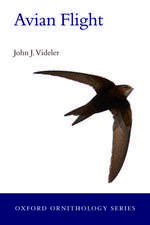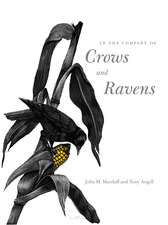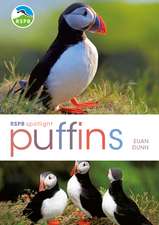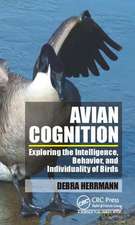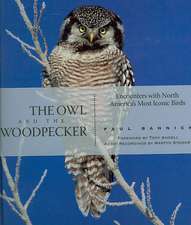Bird Day: A Story of 24 Hours and 24 Avian Lives: Earth Day
Autor Mark E. Hauber Ilustrat de Tony Angellen Limba Engleză Hardback – 5 dec 2023
From morning to night and from the Antarctic to the equator, birds have busy days. In this short book, ornithologist Mark E. Hauber shows readers exactly how birds spend their time. Each chapter covers a single bird during a single hour, highlighting twenty-four different bird species from around the globe, from the tropics through the temperate zones to the polar regions. We encounter owls and nightjars hunting at night and kiwis and petrels finding their way in the dark. As the sun rises, we witness the beautiful songs of the “dawn chorus.” At eleven o’clock in the morning, we float alongside a common pochard, a duck resting with one eye open to avoid predators. At eight that evening, we spot a hawk swallowing bats whole, gorging on up to fifteen in rapid succession before retreating into the darkness.
For each chapter, award-winning artist Tony Angell has depicted these scenes with his signature pen and ink illustrations, which grow increasingly light and then dark as our bird day passes. Working closely together to narrate and illustrate these unique moments in time, Hauber and Angell have created an engaging read that is a perfect way to spend an hour or two—and a true gift for readers, amateur scientists, and birdwatchers.
Preț: 96.52 lei
Nou
Puncte Express: 145
Preț estimativ în valută:
18.47€ • 20.07$ • 15.53£
18.47€ • 20.07$ • 15.53£
Carte disponibilă
Livrare economică 31 martie-14 aprilie
Livrare express 14-20 martie pentru 39.88 lei
Preluare comenzi: 021 569.72.76
Specificații
ISBN-13: 9780226819402
ISBN-10: 022681940X
Pagini: 168
Ilustrații: 24 halftones
Dimensiuni: 121 x 152 x 23 mm
Greutate: 0.25 kg
Ediția:First Edition
Editura: University of Chicago Press
Colecția University of Chicago Press
Seria Earth Day
ISBN-10: 022681940X
Pagini: 168
Ilustrații: 24 halftones
Dimensiuni: 121 x 152 x 23 mm
Greutate: 0.25 kg
Ediția:First Edition
Editura: University of Chicago Press
Colecția University of Chicago Press
Seria Earth Day
Notă biografică
Mark E. Hauber is professor and executive director at the Graduate Center of the City University of New York, and previously served as the Harley Jones Van Cleave Professor of Host-Parasite Interactions at the University of Illinois at Urbana-Champaign. He is the author of The Book of Eggs, also published by the University of Chicago Press. Tony Angell is the author and illustrator of over a dozen books related to natural history, including The House of Owls and In the Company of Crows and Ravens.
Extras
Hearing the scurry of a vole on the forest floor, we see a barn owl emerge from the darkness to catch its prey.
Unless you summer in the Far North or South, midnight represents deep darkness for plants and animals, including humans. Some species certainly embrace the night; they rely on scents, sounds, and even Earth’s magnetic field to find their way. But as most birds depend on sight, you might expect a sleepy, dark start to our bird day. No! Many birds thrive at this time, including owls that have evolved to orient themselves and hunt for their prey in the dimmest of lights. There is perhaps no better example than the barn owl.
Barn owls live pretty much everywhere except Antarctica. But do not take that to mean they are uninteresting. Barn owls can hunt in total darkness. They hear the subtle noises made by voles, mice, rats, and other rodents and can locate them as they rush through the nighttime leaf litter. This requires the owls themselves to be quiet—and they are, flying so silently while hunting that they are able to pick up the softest of sounds from below. Barn owls look relatively large, but their bodies are no bigger or heavier than that of a dove. They are just covered in extra-soft feathers to minimize noise during flight. Large wings and a light body also allow this quieter, slower flight. With these wings, the owls can even hover as they pinpoint their potential prey in the ground cover.
Hearing is one thing, but how do barn owls locate their prey in the dark? Unlike many other owls that have symmetrical ears, the orientation of feathers on the barn owl’s face helps direct sound toward their ears, which are located at different heights. The differing heights help barn owls better perceive subtle changes in the direction and strength of the noises coming from a mouse or vole. This allows them to hear and even create three-dimensional mental maps—matching a sound with the distance to its source, above or below.
Thankfully, tonight is dry. Night rain is the enemy of the barn owl. It dampens their feathers, making flight less quiet, and adds background noise as it falls on the leaf litter, masking the sounds of small mammals scuttering on the ground.
Unless you summer in the Far North or South, midnight represents deep darkness for plants and animals, including humans. Some species certainly embrace the night; they rely on scents, sounds, and even Earth’s magnetic field to find their way. But as most birds depend on sight, you might expect a sleepy, dark start to our bird day. No! Many birds thrive at this time, including owls that have evolved to orient themselves and hunt for their prey in the dimmest of lights. There is perhaps no better example than the barn owl.
Barn owls live pretty much everywhere except Antarctica. But do not take that to mean they are uninteresting. Barn owls can hunt in total darkness. They hear the subtle noises made by voles, mice, rats, and other rodents and can locate them as they rush through the nighttime leaf litter. This requires the owls themselves to be quiet—and they are, flying so silently while hunting that they are able to pick up the softest of sounds from below. Barn owls look relatively large, but their bodies are no bigger or heavier than that of a dove. They are just covered in extra-soft feathers to minimize noise during flight. Large wings and a light body also allow this quieter, slower flight. With these wings, the owls can even hover as they pinpoint their potential prey in the ground cover.
Hearing is one thing, but how do barn owls locate their prey in the dark? Unlike many other owls that have symmetrical ears, the orientation of feathers on the barn owl’s face helps direct sound toward their ears, which are located at different heights. The differing heights help barn owls better perceive subtle changes in the direction and strength of the noises coming from a mouse or vole. This allows them to hear and even create three-dimensional mental maps—matching a sound with the distance to its source, above or below.
Thankfully, tonight is dry. Night rain is the enemy of the barn owl. It dampens their feathers, making flight less quiet, and adds background noise as it falls on the leaf litter, masking the sounds of small mammals scuttering on the ground.
Cuprins
Preface
Artist’s Note
Midnight: Barn Owl (Worldwide)
1 AM: Little Spotted Kiwi (New Zealand)
2 AM: Oilbird (South America)
3 AM: Kākāpō (New Zealand)
4 AM: Common Nightingale (Eurasia)
5 AM: Brown-Headed Cowbird (North America)
6 AM (Sunrise): Silvereye (Australasia)
7 AM: Bee Hummingbird (Caribbean)
8 AM: American Robin (North America)
9 AM: Eclectus Parrot (Australasia)
10 AM: Indian Peafowl (Asia, Introduced Worldwide)
11 AM: Common Pochard (Eurasia)
Noon: Ocellated Antbird (Central America)
1 PM: Secretary Bird (Africa)
2 PM: Emperor Penguin (Antarctica)
3 PM: Superb Starling (Africa)
4 PM: Common Cuckoo (Eurasia)
5 PM: Indian Myna (Asia, Introduced Worldwide)
6 PM (Sunset): Standard-Winged Nightjar (Africa)
7 PM: Great Snipe (Eurasia)
8 PM: Bat Hawk (Africa and Asia)
9 PM: Black-Crowned Night Heron (Worldwide)
10 PM: Cook’s Petrel (New Zealand)
11 PM: European Robin (Eurasia)
Epilogue
Acknowledgments
Further Reading
Index
Artist’s Note
Midnight: Barn Owl (Worldwide)
1 AM: Little Spotted Kiwi (New Zealand)
2 AM: Oilbird (South America)
3 AM: Kākāpō (New Zealand)
4 AM: Common Nightingale (Eurasia)
5 AM: Brown-Headed Cowbird (North America)
6 AM (Sunrise): Silvereye (Australasia)
7 AM: Bee Hummingbird (Caribbean)
8 AM: American Robin (North America)
9 AM: Eclectus Parrot (Australasia)
10 AM: Indian Peafowl (Asia, Introduced Worldwide)
11 AM: Common Pochard (Eurasia)
Noon: Ocellated Antbird (Central America)
1 PM: Secretary Bird (Africa)
2 PM: Emperor Penguin (Antarctica)
3 PM: Superb Starling (Africa)
4 PM: Common Cuckoo (Eurasia)
5 PM: Indian Myna (Asia, Introduced Worldwide)
6 PM (Sunset): Standard-Winged Nightjar (Africa)
7 PM: Great Snipe (Eurasia)
8 PM: Bat Hawk (Africa and Asia)
9 PM: Black-Crowned Night Heron (Worldwide)
10 PM: Cook’s Petrel (New Zealand)
11 PM: European Robin (Eurasia)
Epilogue
Acknowledgments
Further Reading
Index
Recenzii
“‘What do birds do all day long?’ Ecology professor Hauber answers this question by taking an hour-by-hour, worldwide tour of two dozen bird species. . . . Short vignettes about each bird are beautifully illustrated with Tony Angell's lively drawings, bringing the wonders of bird behavior to life.”
"A delightful book by research ornithologist Mark Hauber and illustrator Ton Angell. From owls hunting at night to the common pochard resting with an eye open to spot predators in the daytime, this is a global, hour-by-hour account of individual bird lives."
"Fine drawings by Tony Angell, with a grey background, have a quality recalling old woodcuts."
"[A] delightful, rather quirky window into the world of birds. . . . Hauber’s enthusiasm comes across on every page and Angell’s drawings are superb, capturing the essence of each species to complement the text and illustrating the dark and light hours. This is a book to read in an hour but then to leave around to pick up and savour each entry and its corresponding drawing."
“Bird Day is a brisk, high concept read. It lends the reader a pair of giant wings to soar across the globe, peeking in each hour on the lives of the world’s most fascinating birds. Author Mark Hauber is a research ornithologist, and the text often draws upon his studies. We meet cooperatively breeding superb starlings; a secretary bird that stomps venomous snakes into submission; a duck, keeping one eye open while sound asleep; a bat hawk that swallows its nocturnal prey whole. Lushly patterned chiaroscuro drawings by Tony Angell heighten the mystery and delight of these tall-but-true bird tales.”
“A wonderful book that simultaneously made me nostalgic about a cave full of oilbirds in Trinidad and a kiwi running between my legs in a New Zealand sleet storm—and further informed me about the lives of birds. A brilliant collaboration between a first-rate behaviorist and my favorite bird artist.”
“As much a meditation as a book, Hauber and Angell’s Bird Day gives us a bird to think about at each hour of the day and night. They take us around the world, visiting birds including the brown-headed cowbird (5 a.m.), Hauber’s own research subject, the ocellated antbird (noon), Cook’s petrel in New Zealand (10 p.m.), and twenty-one others. The narrative brilliantly captures the moment; the art makes the moment come alive. Bird Day is an excellent pairing of text and art, one I will return to again and again as the hours go by.”
“One could not ask for two better field companions than Mark Hauber and Tony Angell as they observe some of the world’s most interesting birds. Their book gives us all new ways of seeing, hearing, and thinking about them—hour by hour—without ever leaving home.”
“Stunning. . . . Sometimes we are oblivious to miraculous objects in our daily lives.”
“Angell writes (and draws) with the absolute authority of one who has studied, rehabilitated, lived with, and loved the animals his whole life.”
